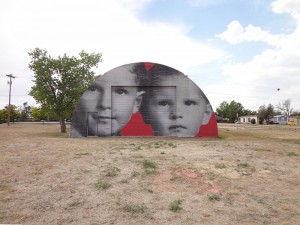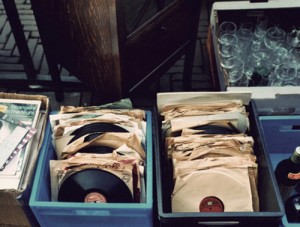
M12 – The Big Feed: On Rural Contemporary Art and Community Engagement
In small towns across America, a tradition of throwing a big social gathering at the end of harvest season prevailed. It’s an idea we still see purported in films and on TV, but in reality, these events are disappearing as the populations of small, rural communities dwindle.
However, in Byers, on the eastern plains of Colorado an hour from Denver, the nonprofit arts collective M12 hosted The Big Feed last weekend. Part art show, county fair, hoedown and foot-stomping celebration of rural culture this contemporary art event unfolded at the Quint Valley Rodeo Grounds.
M12 is putting contemporary art practices and real life in rural communities together—relational aesthetics on the eastern plains—by putting people in a social environment to participate in a shared activity. But more than simply envisioning the audience as community, M12 is engaging with a living community.
And they don’t necessarily call what they are doing art. Instead they prefer the term “community engagement” according to Kirsten Gerdes-Stoltz, one of the founding members and directors of the collective.
“It’s about building something different. It’s about revitalization. It’s not about the gallery and selling the widgets,” Gerdes-Stoltz said.
Gerdes-Stoltz understands the realities of disappearing small towns. She’s a fifth generation Coloradoan from Yuma (not far from Byers). Her parents left when she was five, but her grandparents and great-grandparents remained. However, these formerly (and somewhat current) agricultural communities provide little hope for young people to stay or even return to their hometowns and earn a living or build a life.
Gerdes-Stoltz has partnered with Richard Saxton and Brian Cook to create M12. They recently opened the Office for Connective Aesthetics in Byers. Not relational (the way two or more people or things are connected), but connective (the something that connects).
“We strive to be stewards of effective local and global creative problem solving, and a community resource for evolutionary thinking and innovative communication,” their website states.
M12 is connected via Saxton to CU Boulder. Saxton teaches the Art and Rural Environments Field School. He and Gerdes-Stoltz are interested in the experimental efforts of artist forging new connections with communities and people, but also connection with the surrounding landscape.
Their engagement in the community is bottom up. They are working with local folks in Byers to develop the process. Recent wildfires destroyed part of a bird sanctuary and M12 is working with a church in Last Chance to revitalize the site. And they are engaging with folklorists to preserve community stories and generational knowledge.
And then there’s the Big Feed.
With livestock displays by the Deer Trail chapter of the Future Farmer’s of America and DJ Rockcrusher spinning country music 78s (vinyl records) from the 1970s and 80s, and a pit-roasted bison barbeque, it could be any small town hoedown or county fair. But this event includes art and exchange projects presented by students at CU Boulder in the program for Art and Social Practice; a reading by South Dakota author Josh Garret-Davis from his book Ghost Dances; and a film screening of Men of Steel by Jeff Himpele and Marty Muse about the history of the steel guitar and much more.
From dirt track care racing to “Action on the Plains” a project by Jetsonorama of large scale wheat pasting on Quonset huts and grain bins at the Turecek Farm to the “Experimental Site for Rural Creativity” in Last Chance, M12 is forging a new perspective for contemporary art and rural life that is real, organic and evolutionary.
Whether or not they can prove their premise that contemporary art does not need to exist only in urban centers remains to be seen. But by inviting artists from around the world to focus on the urban and rural divide and to engage specifically with the vernacular of Colorado’s high plains, they have sparked a dialogue, and they have taken curating out of the museum and plopped it squarely into real life.





